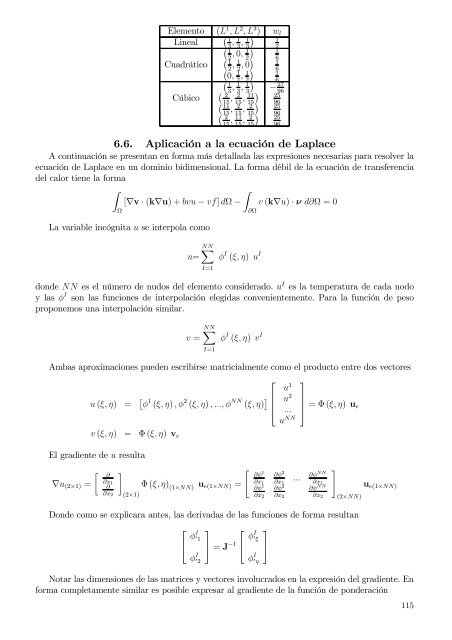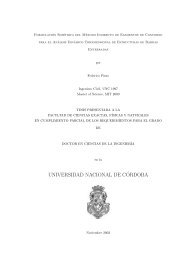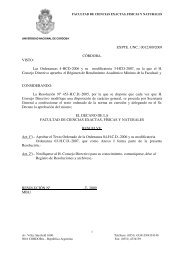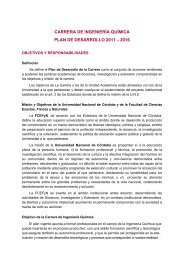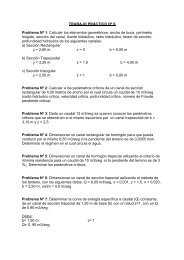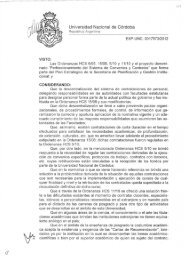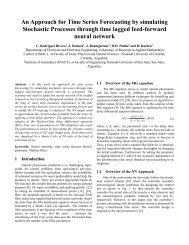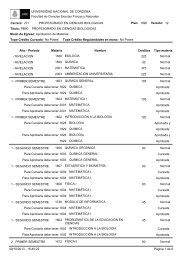Capítulo 1 Métodos de residuos ponderados Funciones de prueba ...
Capítulo 1 Métodos de residuos ponderados Funciones de prueba ...
Capítulo 1 Métodos de residuos ponderados Funciones de prueba ...
You also want an ePaper? Increase the reach of your titles
YUMPU automatically turns print PDFs into web optimized ePapers that Google loves.
Elemento (L<br />
( 1 , L 2 , L 3 ) w l<br />
Lineal 1 , 1, 1 1<br />
( 3 3 3)<br />
2<br />
1 , 0, 1 1<br />
( 2 2)<br />
6<br />
Cuadrático 1 , 1, 0) 1<br />
( 2 2 6<br />
0,<br />
1<br />
, )<br />
1 1<br />
( 2 2 6<br />
1<br />
( 3 , 1 3 , 3)<br />
1 − 27<br />
96<br />
Cúbico 2<br />
15 , 2<br />
15 , )<br />
11 25<br />
( 15 96<br />
11<br />
15 , 2<br />
15 , )<br />
2 25<br />
( 15 96<br />
2<br />
15 , 11<br />
15 , )<br />
2 25<br />
15 96<br />
6.6. Aplicación a la ecuación <strong>de</strong> Laplace<br />
A continuación se presentan en forma más <strong>de</strong>tallada las expresiones necesarias para resolver la<br />
ecuación <strong>de</strong> Laplace en un dominio bidimensional. La forma débil <strong>de</strong> la ecuación <strong>de</strong> transferencia<br />
<strong>de</strong>l calor tiene la forma<br />
∫<br />
∫<br />
[∇v · (k∇u) + bvu − vf] dΩ −<br />
Ω<br />
La variable incógnita u se interpola como<br />
∂Ω<br />
v (k∇u) · ν d∂Ω = 0<br />
u=<br />
NN∑<br />
I=1<br />
φ I (ξ, η) u I<br />
don<strong>de</strong> NN es el número <strong>de</strong> nudos <strong>de</strong>l elemento consi<strong>de</strong>rado. u I es la temperatura <strong>de</strong> cada nodo<br />
y las φ I son las funciones <strong>de</strong> interpolación elegidas convenientemente. Para la función <strong>de</strong> peso<br />
proponemos una interpolación similar.<br />
v =<br />
NN∑<br />
I=1<br />
φ I (ξ, η) v I<br />
Ambas aproximaciones pue<strong>de</strong>n escribirse matricialmente como el producto entre dos vectores<br />
u (ξ, η) = [ φ 1 (ξ, η) , φ 2 (ξ, η) , ..., φ NN (ξ, η) ] ⎡<br />
v (ξ, η) = Φ (ξ, η) v e<br />
El gradiente <strong>de</strong> u resulta<br />
⎢<br />
⎣<br />
u 1<br />
u 2<br />
...<br />
u NN<br />
⎤<br />
⎥<br />
⎦ = Φ (ξ, η) u e<br />
∇u (2×1) =<br />
[ ∂<br />
∂x 1<br />
∂ Φ (ξ, η) (1×NN)<br />
u e(1×NN) =<br />
∂x 2<br />
](2×1)<br />
[<br />
∂φ<br />
1<br />
∂φ 2<br />
∂x ∂φ 1 ∂φ 2<br />
∂x 2 ∂x 2<br />
∂x 1<br />
...<br />
∂φ NN<br />
∂x 1<br />
u<br />
∂φ NN<br />
e(1×NN)<br />
∂x 2<br />
](2×NN)<br />
Don<strong>de</strong> como se explicara antes, las <strong>de</strong>rivadas <strong>de</strong> las funciones <strong>de</strong> forma resultan<br />
⎡<br />
⎣ φI′ 1<br />
⎤ ⎡<br />
⎦ = J −1 ⎣<br />
φ I′ ξ<br />
⎤<br />
⎦<br />
φ I′ 2<br />
φ I′ η<br />
Notar las dimensiones <strong>de</strong> las matrices y vectores involucrados en la expresión <strong>de</strong>l gradiente. En<br />
forma completamente similar es posible expresar al gradiente <strong>de</strong> la función <strong>de</strong> pon<strong>de</strong>ración<br />
115


